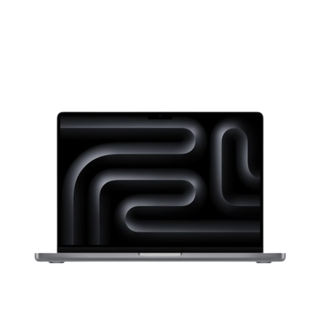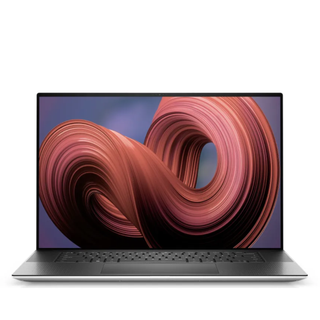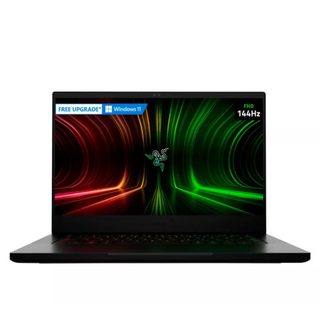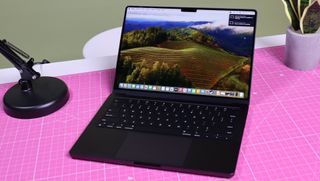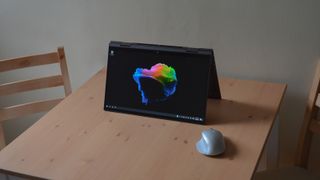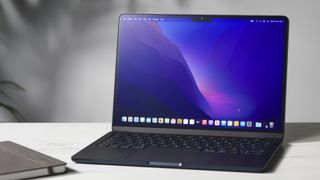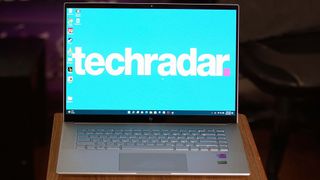Best video editing laptops of 2024
Explore the best video editing laptops for cutting content on the go

The best video editing laptop will power through all your video projects when you're at home, in the studio, or on the go.
Our expert team of reviewers have tested the best video editing computers , the best monitors for video editing and the best video editing Mac and MacBook. So, we understand what you'll want to check when choosing your next machine. Through our tests, the Apple MacBook Pro 14-inch proved the best laptop for video editing - powered by the speedy M3 processor, it's fast, fluid, and makes content creation seamless. On Windows, we recommend checking out the Dell XPS 17, with a beautiful, broad canvas to work on.
We've rounded up our favorite devices for producing video content, and as part of our review process, we've checked out specs, features, design, and battery life. We've also reviewed color-accurate screens for coverage across the sRGB and DCI-P3 spaces and benchmarked performance running the best video editing software.
The quick list
Best overall
An incredibly powerful laptop with an impressive screen and a battery life that beats all others, this is the best laptop to get for video editing.
Best on a budget
Though a 2-in-1, this is an affordable yet powerful and versatile alternative to the MacBook Air if you prefer a Windows laptop for video editing.
Best for 4K
One of the slickest and sleekest 17-inch laptops around, it also boast a stunner of a 500-nit 4K display and a battery life to last you all day.
Best portable
If you want a powerful laptop that feels like air in your pack, this aptly-named thin and light laptop is the way to go. It's fairly affordable as well.
Best mid-range
With its gorgeous 16-inch 4K OLED screen and powerful specs, this affordable Windows option is a solid one for content creation.
Best for gaming
Elegant, lightweight, and with a fantastic 1440p screen, this powerful thin and light laptop remains a compelling choice despite its steep price tag.
Load the next products...
Best mobile workstation
If you prefer to stay tethered to your desk, this is mobile workstation won't compromise on power and and video editing performance.
Best for beginners
If you're just starting your video editing journey, the older M1-powered Apple MacBook Air is a great companion. A powerful performer that's not as expensive as other MacBook laptops.
Best video editing laptop overall
Specifications
Reasons to buy
Reasons to avoid
The Apple MacBook Pro M3 Max is our best video editing laptop overall, thanks to a fast performance and a vivid screen wrapped in a highly portable aluminum chassis.
Popular across the creative community, MacBook Pros have long been our top choice for best video editing laptops - and the latest M3-powered models are, frankly, in a class of their own. If you want absolute performance here, opt for the M3 Max CPU - it works hard and plays hard.
That's because, in a sense, we found the 14in MacBook Pro M3 Max to effectively be a Mac gaming rig. It's fast, powerful, never skips a beat - performance was flawless during our time with the machine. Capable of playing triple-A games without issue, it's more than capable of running high-end video editing software. During our tests, we ran 4K 30fps video and 4K 24fps ProRes HDR content in Final Cut Pro, and found it extremely easy to edit the footage. Better still, the laptop still has - for now at least - a 3.5mm audio jack, making it ideal for video content creators.
The classic Apple aesthetic remains, solidly built and beautiful from every angle. We've picked the 14in model here for its overall portability and power for the price. A 16in version is available if you need a larger screen for your video projects (sadly, Apple has discontinued the 13in in the M3 line-up). The only real downside, beyond the fans getting noisy under heavier workloads, is the high price. Like most Apple products, the MacBook Pro 14-in M3 Max is an investment for video editors.
Read our full Apple MacBook Pro 14-inch M3 Max (2023) review
Best budget laptop for video editing
Specifications
Reasons to buy
Reasons to avoid
If you're looking for the best laptop for video editing on a budget, the HP Envy x360 is a good choice. When you edit video while on the go a "convertible laptop" or 2-in-1 laptop can be handy to boost your creative process. You can use it as a tablet for previewing your source material or exploring transitions with the touch screen, then the next minute load up your complex non-linear video editor and use it with the keyboard.
After testing out the HP Envy, we can confidently state that its 15.6-inch, full HD 1080P WLED display looks gorgeous and is more than adequate for video editing on the go. If need be, you can connect it to an external monitor or large screen TV via its HDMI or DisplayPort via USB-C. While this isn't a 4K 17-inch screen laptop replacement, what you lose by not having an extra-large display and 4K resolution you make up for when it comes to battery life.
Packed inside is an eight-core AMD Ryzen 7 5700U with Vega graphics, a speedy CPU that makes up for the lack of a discrete GPU. In our tests, the Ryzen 7 5500U racked up impressive benchmark scores. It held its own against the more expensive 2-in-1's running an Intel Core i7-1165G7. The Envy x360 15 also made short work of our Blender benchmarks, rendering in less than half the time of the ThinkBook 14s Yoga. Based on that, the Envy x360 15 is a good option for creatives working to a budget.
For an alternative budget laptop, we'd recommend looking for an M1 MacBook Pro or MacBook Air. You can pick up models with the older chipset at cheaper prices now and they're still creative powerhouses for video editing.
Read our full HP Envy x360 review
Best 4K video editing laptop
Specifications
Reasons to buy
Reasons to avoid
Big and bold, with a vibrant display, discrete GPU, and outstanding performance, the XPS 17 is a top contender for best video editing laptop overall - especially if you prefer using Windows. But what really sets this apart is that glorious 4K UHD+ display for impressive detail.
With a 16:10 aspect ratio, the IPS panel boasts some impressive specs for editors looking for a laptop with color accuracy. There's the 0.24 Delta-E, and color spaces are well-represented with 188.8% sRGB and 133.7% DCI-P3. It's a sleek machine, chassis beautifully designed in machined aluminum and keyboard surrounded by a carbon fiber that will be very comfortable during those long editing projects.
It's not perfect. The XPS 17 is large, heavy (5.37 lbs / 2.44 kg), and the battery life isn't the best - we clocked it at just over nine hours. So, it's not one you want to lug around too often, And for the premium price, we expect more than the mediocre 720p webcam. It is brighter than a lot of laptops for video editing, but at around 500nits, it's not by much. With the right content, the MacBook Pro can hit 1600nits.
But when even the base configuration (FHD non-touch screen, Intel i7, 16GB RAM) will give you enough power for basic projects, it's difficult not to be impressed with the laptop's performance for video editing.
Read our full Dell XPS 17 review
Best laptop for video editing on the go
Specifications
Reasons to buy
Reasons to avoid
Plenty of the best laptops for video editing are extremely portable - but at 2.7 lb / 1.24kg, the MacBook Air offers a potent mix of portability and performance that others, like the HP Spectre x360, can't quite match.
But then, this is a laptop that's been designed for on-the-go video editors, photographers, and designers. It's sleek, slim, beautiful to look at - and small enough to slide into your bag and carry with you just about everywhere. There will be trade-offs for such a compact laptop. Chiefly, the screen size, which is just 13.6in with a resolution of 2560x1664. If you need a broad canvas to edit video, this laptop isn't for you.
If that's not a concern, the performance of the MacBook Air M2 is a delight. In our own tests, we edited 4K movies with ease, and the laptop remained almost entirely silent throughout operation. However, we will say, that for professional-grade video editing work, we'd recommend opting for one of the upgraded models over the base configuration, which will bump up the price. If you’re on a budget but don't want to skimp on performance, the older MacBook Air M1 is still a great video editing laptop for the price.
Read our full Apple MacBook Air (M2, 2022) review
Best mid-range video editing laptop
Specifications
Reasons to buy
Reasons to avoid
Looking for a mid-range Windows laptop for video editing? Designed for video editing, photo editing, even game development, the HP Envy 16 is suitably powerful for the price.
The laptop's performance for creative tasks proved excellent in our tests. We ran Premiere Pro and Photoshop, and had no issues with either, even with high-resolution media and multiple layers. So long as you're not planning on doing heavy triple-A gaming on the side, you'll have no problems running creative software on the machine.
The display can make or break a video editing laptop - and there's no complaints here. The Envy 16 features a 16:10 4K panel that boasts 100% sRGB, 100% Adobe RGB, and a low Delta E for color accuracy. No DCI-P3, which is typically used in video editing, but it shouldn't affect most general workflows.
We did find that the battery life wasn't great - in our benchmark test, it lasted almost 6.5 hours, and it'll be less if you're editing a lot of complex videos. And it's not the coolest or quietest video editing laptop we've tried. But for an all-rounder with that's not quite budget and not quite premium, we found the HP Envy 16 ideal.
Read our full HP Envy 16 review
You could save on HP products with our HP coupon codes.
Best laptop for video editing and gaming
Specifications
Reasons to buy
Reasons to avoid
A lot of gaming laptops are good for video editing, since they're focused on high performance and graphic fidelity. And the Razer Blade 14 is our pick of the bunch of you want to a machine for work and play.
It's a thin, lightweight, speedy laptop that packs a lot more power than you might expect. In our tests, it easily, and surprisingly, came close to matching the performances of the more powerful Legion 7i Pro and ROG Zephyrus M16. When it comes to creative tasks, the Blade 14 scored well across our 25GB File Copy, Handbrake, and CrossMark tests. So, you'll have no issues running Premiere Pro here.
That's not the only reason we like this laptop for video editing. The 16:10 screen, though a compact 14 inches, is a sharp QHD+, with a detailed resolution 2560x1600. Better still, it boasts 100% DCI-P3 color space coverage, which is essential for many video projects. Elsewhere, we were impressed with the audio quality of the dual speakers (and yes, there's a 3.5mm audio jack for wired headphones).
Battery life isn't particularly good, and although it's slated to last 10 hours, we could only squeeze about 8 hours out of it. And that's for basic use like emails, web browsing, office apps. Expect around four hours if you're editing footage, playing games, or streaming movies. There's otherwise plenty to love about this laptop.
Read our full Razer Blade 14 review
Check out our Razer promo codes to get the best deal on your next purchase.
Best mobile workstation for video editing
Specifications
Reasons to buy
Reasons to avoid
Lenovo’s ThinkPad P17 Mobile Workstation may not be the best choice if you just want to grab your laptop and work in the coffee shop for a couple of hours. But if you need to setup and get some serious creative work done, this mobile workstation easily handles everything from video editing to 3D modeling.
Strong, sturdy, and a powerhouse under the hood, it’s not the fastest on the block, but it is fast enough. Our Lenovo ThinkPad P16 featured an i9 2.30GHz CPU, an Nvidia RTX A5500 GPU, and 64GB RAM that can be swapped out - more than enough for video projects. The 16-inch multi-touch display shows a resolution of 3840x2400. 2TB of storage should easily see most editors through the next project.
During our PCMark testing, the P16 scored 7651 on the extended test, meaning that compared to other portable workstations, it stacks up well - not the absolute fastest, but close. The focus here is on raw under-the-hood power. Little wonder we ranked this as one of the best laptops for video editing, photo editing, and just about any other creative task you need to power through.
Read our full Lenovo ThinkPad P16 Mobile Workstation review
Find great deals on laptops with our Lenovo promo codes.
Best video editing laptop for beginners
Specifications
Reasons to buy
Reasons to avoid
It may be several years old now, but the MacBook Air M1 remains one of the best laptop for video editing. This is a good pick if you're looking for an entry-level machine. It might not be as powerful as Apple's newer M2-powered machine, but as an older model, it's now cheaper than the current Apple line-up.
Performance, in our tests, were excellent, coming close to matching the benchmark test results of the better-specced MacBook Pro M1 (another great video editing laptop option). Although Apple says the MacBook Air M1 can handle up to 4K video editing, we actually tried editing videos in 8K using Final Cut Pro. Happily, the laptop did a fantastic job here.
As you'd expect with Apple devices, the screen is a vibrant delight, with a crisp 2560x1600 resolution and True Tone technology to match the ambient light of your surroundings. It's not the brightest (just 400nits), but acceptable if you're just starting out. And we especially appreciated the video editor-friendly 100% DCI-P3 color coverage.
Bonus points, too, for that extra-long battery life and near-silent operation thanks to its fanless design. We do have concerns about how the laptop handles excessive heat without the fan, with the potential to throttle performance of resource-intensive video editing software, although we can't say we experienced any issues during our review process, and it likely won't be a concern if you're a beginner.
Read our full Apple MacBook Air (M1, 2020) review
Find deals on Apple products with our Apple voucher codes.
How to choose the best video editing laptop for you
When choosing which video editing laptop is best, there are several factors to take into account. As we said before, it's not simply a case that the most expensive, most powerful will be right for post-production. In general, those in the creative industries prefer Apple devices - which is why the Apple MacBook Pro 16" is highly rated - but you'll find plenty of top Windows laptops for video editing. Check your preferred software to see what operating systems are supported.
Most video editing software depends on the CPU - it keeps the engine driving as the speeds top video editors are most comfortable. so opt for the best CPU in your budget.
Video editing apps are also heavyweight in terms of memory usage, so look for laptops with the best RAM. To work with heavyweight video editors like Adobe Premiere Pro you will need 16GB of RAM to plod away comfortably, although technically it can run with just 8GB.
A fast GPU will also help once you get past simple chopping up footage and start adding transitions, overlays and other fancy effects. Finding the best GPU used to be less important, but it's becoming more popular especially for creatives working with specific video editors, the best VFX software, and best 3D modeling software.
The operating system should have a rather large solid state disk so both it and applications load and run quickly with plenty of scratch space. Ultimately though, it will be the resolution of your video production which will steer you towards your final system requirements, with screen size being one of the most important.
In general, if your video production is full HD or 1080p, any laptop will be adequate. However, once you move to 2K or higher, you will prefer a "higher than Full HD" screen resolution on your system, we're talking QHD and UHD for working with 2K and 4K video, respectively. For professionals, it's recommended to look for color accurate panels. These screens produce a superior color accuracy, so the images on the display perfectly match the final export - whether it's for the big screen or the small screen.
Other good factors to consider are choosing a device that is expandable (so that you can add more memory or an additional SSD if necessary), one that comes with next business day warranty (or at least offers it as an option) and a device that features ample connectivity as users are likely to transfer files via any of the best cloud storage services or through external storage like the best portable SSDs.
Best video editing laptop: FAQs
What specs does my video editing laptop need?
Why you can trust TechRadar
| Specs | Minimum | Recommended | Ideal |
|---|---|---|---|
| Editing resolution | 1080p (1920 x 1080) | 4K (3840 x 2160) | 4K (3840 x 2160) |
| Processor | 8th Generation Core i5 or equivalent AMD Ryzen | 8-core Intel CPU or equivalent AMD | Intel Xeon or better |
| Memory | 16GB | 32GB | 64GB |
| Storage | 256GB SSD | 256GB NVMe PCIe SSD | 1TB NVMe PCIe SSD (RAID-0) |
| Screen | Full HD | 4K | 8K |
| Video card | Integrated | Discrete | Nvidia RTX or AMD Radeon Pro |
Is Mac or PC better for video editing?
Generally, Macs and MacBooks are considered the best laptops for video editing. Popular across the creative industry - and a mainstay of many an editing bay - MacBooks boast incredible screen technology, color accuracy, and blisteringly fast performance speeds. All of which make most of the laptop line-up - from MacBook Air to the MacBook Pro - suitable for editing videos.
But that's not to say you can't use a Windows laptop for video editing, but with so many more on the market, you'll want to double-check the specs to ensure it can handle resource-hogging video editing software, and has a color-accurate screen.
Can any laptop be used for video editing?
Not all laptops can be used to edit videos - has to be the right laptop with the right specs.
We reached out to Michel Yavercovski, Senior Director of Product Management for Corel video products, to get his expert opinions about choosing a creative computer.
"There are a few key things to look for when buying a video editing laptop and, of course, when you’re talking about video, the better the hardware, the smoother and more responsive your editing experience will be. Whether you’re talking about our Pinnacle Studio or VideoStudio products, both have been designed to take full benefit of your hardware to make video editing as fast and efficient as possible," said Michel.
Processors
"First, you’ll want to look for a system with a powerful multicore processor -- the Intel Core i7 product line is a good choice to get started with -- and our software has been optimized to take advantage of multithreading so you can get the most out of these impressive chips. A powerful processor will also give you a seamless experience when working with today’s popular formats and creative features like multi-camera and 360° video support. 4K video can create huge file sizes, so you’ll also want to make sure the device has a large and fast SSD storage drive that can read and write large video files without any hang-ups."
Memory
"Video editing takes up a lot of memory, so shop for a system that has between 16GB and 32GB of RAM to keep things running smoothly. And, of course, a 64-bit version of Windows 10 is a must. "
Graphics card
"Then, when considering graphics cards, look for the latest NVIDIA GeForce RTX or GTX series as well as Intel Iris or HD Graphics for overall faster processing and editing. Most advanced graphics cards will also have HEVC support, enabling the use of this advanced video format in your productions."
Display
"Since you’ll be working primarily on one screen when you’re on the go, make sure the laptop's built-in monitor produces crisp images and has accurate color rendering. It’s also ideal to have a system that will support multiple screens for when you’re back in your main work space."
Battery
"Lastly, I always advise users to either plug in their laptops or adjust the power settings for high performance since many notebooks default to power-saving features when they’re running on battery which can impact performance. You may have to accept a shorter battery life, but it will ensure faster processing for a great editing experience."
Are Chromebooks good laptops for video editing?
No. Even the best Chromebooks aren't a good choice for editing videos. These portable lack large storage facilities and the specs required to run video editor software - most software requires a good CPU, GPU, and RAM to run flawlessly. However, you may have some luck using the best video makers to create simple content in your browser on a Chromebook. The best video editing apps are a good alternative to video editing on Chromebooks. These accessible apps run on Android, iPhone, and iPad devices, offering surprisingly powerful tools for cutting content easily.
How can I speed up my video editing?
Hugely experienced edit trainer and colourist, Darren Mostyn, guides us through some essential steps to accelerate editing routines in a bid to make your workflow even more efficient.
I have been editing for over 25 years and thought I would share some of my best tips on how to speed up your editing skills. Most of this advice applies to any editing application. Even a 1% or 2% increase in speed could improve your productivity by over half an hour a week. That’s time you can take off and enjoy or add to the workload and increase your income. Having worked in broadcast sport and live events editing for around a decade, I had to edit super-fast to turn highlights of live action around in some crazy tight deadlines.
Before we get in to the steps, here’s something to keep in mind. Editing quickly is not necessarily why we are employed. But by being quick at the mechanical process of editing also leaves more time for the ‘real’ job – crafting the story, supporting the performances, controlling the pace and engaging the audience, and so on.
- Learn your keyboard shortcuts. My first piece of advice is to know your keyboard shortcuts inside out. Any menu that you use more than twice a day will likely have a keyboard shortcut or can be mapped to a keyboard. Just take the time to find the shortcut and practise using it. You may find this slows you down to start with, but it will increase your speed over time. Force yourself to use the shortcuts. Combine that with using a dedicated colour coded keyboard available for most NLEs by third party keyboard manufacturers. DaVinci Resolve users like myself can use a dedicated keyboard called the Speed Editor (ed: Other popular video editing apps are likely to have bespoke consoles as well). Don’t forget that you can change shortcuts if you need to – I spent many years alternating between Avid, Final Cut Pro and Adobe Premiere, so now when I edit I have a set of shortcuts that are a hybrid. How flexible you can be will depend on your NLE.
- Get training. Invest in some quality training. Whilst this may seem like an expensive outlay, the return on investment can be rewarding. Spending hours looking at YouTube channels hoping that the information is correct can be a potential waste of your time. A structured course will give you more confidence in playing with new techniques – you may find you have been working in a certain way for years only to discover there is a much easier and quicker approach available.
- Time management. Your mind will be far more productive if you take breaks. It is believed that 2-3 hours of concentrated work, followed by a short break, is far more effective than 4 or 5 hours straight editing. Get all the emails and social media checks done in the break, but actually take a break from your screen too. Go for a walk or something active, then carry on working for a few more hours - it is good for your body not to be sat in a chair for hours on end. You’ll come back with higher levels of concentration. Be comfortable – this applies to everything. Nothing slows you down more than a bad back or an aching wrist. Invest in a good ergonomic chair or even a standing desk and make sure your monitors are at the right height.
- Cheap media is a false economy Use faster hard drives and quality card readers if you are responsible for transferring data. Cheap hard drives and card readers will slow down your transfer speeds considerably. I invested in a decent USB hub after years of using cheap ones and the transfer times are lightning quick. If you can get your data onto SSD drives, you will save so much time over regular drives. Editing and rendering times will also benefit from faster hard drives. You can consider making proxy files from your footage to help with workflow bottlenecks you may encounter on slower machines.If we are making proxies for use in an Avid workflow, we use DaVinci Resolve to generate them as it is quicker.
- Use a decent computer. Learn your NLE’s proxy workflow if your computer is struggling. Two monitors or an Ultrawide monitor will help you organise your edit and a third monitor for previewing full screen is ideal. Nothing is more frustrating than being slowed down by the hardware. (ed: The jury is still out on screen resolution)
- Freshen up your human interface. A Wacom digitizing tablet and pen will not only speed up your editing but also reduce fatigue in your wrist. I have not used a mouse since discovering Wacom tablets around 20 years ago. I have a small portable size tablet that I can take on the road with me if I am working away from the studio. I currently use an Intuos 3, which is old now, but they are built so well that it still works like new. The fact that I can keep the pen in my hand at all times makes it faster for me to work. Once you have set them up correctly for your comfort and assigned shortcuts to the keys, you will never need a mouse again. If you have to draw any masks or audio levels, it is far easier to use the pen. It takes a bit of getting used to and will slow you down at the start, but you will soon gain speed.
How we test the best video editing laptops
We test a range of hardware, including the best business laptops to suit a range of budgets and workflows.
When testing the best laptops for video editing, we took into account the recommended hardware requirements from popular non-linear video editors and published benchmarks like Puget Systems’ Premiere Pro benchmark. We also use a range of apps, from the best video editing software for beginners to the best Adobe Premiere Pro alternatives, for a well-rounded view of what each machine is capable of when it comes to performance.
Given the above requirements and information, we selected laptops with 16GB of RAM or more -32GB preferred- with 1TB or more of fast internal SSD storage and the latest-generation CPUs from AMD, Intel and Apple. We had to make an exception in the rugged category as an Intel i7 is the fastest at the time of writing.
As a result, a laptop chosen from this list will be as suitable for the task at hand a year down the line as it is today. Offerings from Apple, Dell, Lenovo, HP, and Razer all offer some of the best laptops for video editing. For broader options, our testing process also evaluated performance one of the best 2-in-1 laptops, the best mobile workstations - performance powerhouses built for resource-intensive tasks. We also considered several of the best gaming laptops. Since modern games are resource-intensive in terms of CPU, RAM and GPU, these are exceptionally well-suited as video editing laptops.
Learn more about our extensive review process in our guide How we test, review, and rate business laptops on TechRadar Pro.
Are you a pro? Subscribe to our newsletter
Sign up to the TechRadar Pro newsletter to get all the top news, opinion, features and guidance your business needs to succeed!

Désiré has been musing and writing about technology during a career spanning four decades. He dabbled in website builders and web hosting when DHTML and frames were in vogue and started narrating about the impact of technology on society just before the start of the Y2K hysteria at the turn of the last millennium.
- Fernando Cassia
- Steve ClarkB2B Editor - Creative & Hardware
- Michelle Rae UyContributor
